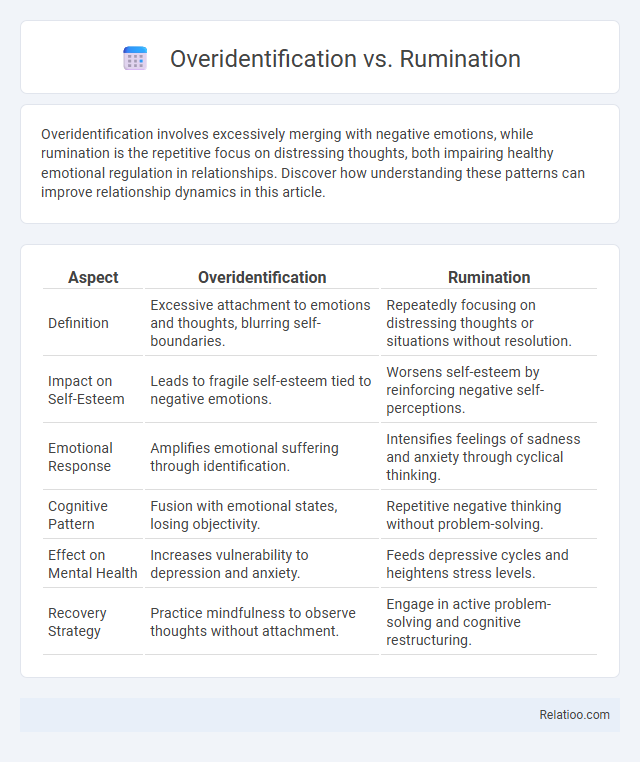Overidentification involves excessively merging with negative emotions, while rumination is the repetitive focus on distressing thoughts, both impairing healthy emotional regulation in relationships. Discover how understanding these patterns can improve relationship dynamics in this article.
Table of Comparison
| Aspect | Overidentification | Rumination |
|---|---|---|
| Definition | Excessive attachment to emotions and thoughts, blurring self-boundaries. | Repeatedly focusing on distressing thoughts or situations without resolution. |
| Impact on Self-Esteem | Leads to fragile self-esteem tied to negative emotions. | Worsens self-esteem by reinforcing negative self-perceptions. |
| Emotional Response | Amplifies emotional suffering through identification. | Intensifies feelings of sadness and anxiety through cyclical thinking. |
| Cognitive Pattern | Fusion with emotional states, losing objectivity. | Repetitive negative thinking without problem-solving. |
| Effect on Mental Health | Increases vulnerability to depression and anxiety. | Feeds depressive cycles and heightens stress levels. |
| Recovery Strategy | Practice mindfulness to observe thoughts without attachment. | Engage in active problem-solving and cognitive restructuring. |
Understanding Overidentification: A Psychological Overview
Overidentification involves merging one's identity completely with thoughts or emotions, leading to a loss of perspective and heightened emotional distress. Unlike rumination, which is repetitive and passive focus on negative events, overidentification causes individuals to equate their self-worth directly with these experiences. Understanding overidentification is crucial in clinical psychology as it impacts emotional regulation and contributes to disorders such as depression and anxiety.
Defining Rumination: Patterns and Pitfalls
Rumination involves repetitive, passive focus on distress, its causes, and consequences, often hindering problem-solving and emotional recovery. Overidentification intensifies rumination by merging your identity with negative thoughts, making it harder to detach from emotional pain. Recognizing these patterns helps you break the cycle and foster healthier coping mechanisms.
Key Differences Between Overidentification and Rumination
Overidentification involves excessively identifying with negative emotions, causing you to feel overwhelmed and lose perspective, while rumination consists of repetitively thinking about distressing situations or thoughts without resolution. The key difference lies in the focus: overidentification centers on feelings and emotional absorption, whereas rumination is characterized by persistent cognitive replay of problems. Recognizing these distinctions helps your mindfulness practice by targeting emotional detachment for overidentification and cognitive restructuring for rumination.
The Emotional Impact of Overidentification
Overidentification intensifies your emotional distress by causing you to fuse your identity with negative thoughts and feelings, making it difficult to detach and gain perspective. Unlike rumination, which involves repetitive thinking about problems, overidentification leads to an overwhelming sense of personal failure and helplessness. This emotional impact can exacerbate anxiety and depression, hindering your ability to regulate emotions effectively.
Cognitive Consequences of Rumination
Rumination involves repetitive and passive focus on negative thoughts, which significantly impairs cognitive functions such as attention, problem-solving, and memory. Your mental resources become consumed by persistent self-focused attention, reducing the ability to engage in effective decision-making and adaptive coping strategies. Overidentification amplifies this effect by causing you to merge with negative emotions, while overidentification as a distinct construct emphasizes excessive attachment to one's internal experiences without productive resolution.
Common Triggers for Overidentification and Rumination
Common triggers for overidentification and rumination include negative self-evaluations, unresolved emotional experiences, and stressful life events that intensify your focus on perceived personal flaws or failures. Overidentification often arises when you excessively associate your identity with these negative emotions, leading to a loss of perspective and heightened emotional distress. Rumination involves repetitive, passive focus on distressing thoughts or problems, which can prolong emotional suffering and hinder problem-solving abilities.
How Overidentification Affects Mental Wellbeing
Overidentification, characterized by excessive attachment to negative emotions and self-concepts, intensifies mental distress by reinforcing negative thought patterns and emotional reactivity. This cognitive distortion can lead to increased anxiety, depression, and impaired emotional regulation, as individuals become consumed by their perceived problems and failures. Unlike rumination, which involves repetitive thinking about problems, overidentification specifically amplifies self-critical perspectives, undermining resilience and overall mental wellbeing.
Rumination and Its Link to Anxiety and Depression
Rumination involves persistent and repetitive thinking about distressing symptoms and their possible causes or consequences, intensifying feelings of anxiety and depression by maintaining a focus on negative emotions and experiences. Psychologically, rumination prolongs emotional distress by preventing problem-solving and impeding cognitive disengagement from negative thoughts, often resulting in higher risk and severity of mood disorders. Research indicates that individuals with high levels of rumination exhibit increased amygdala activation and disrupted connectivity with prefrontal regions, exacerbating depressive and anxious symptomatology.
Strategies for Reducing Overidentification and Rumination
Strategies for reducing overidentification and rumination include practicing mindfulness to increase awareness of your thoughts without judgment, which helps create distance from overly identifying with negative emotions. Cognitive-behavioral techniques such as challenging and reframing negative thought patterns reduce repetitive, unproductive thinking. Engaging in activities that promote emotional regulation, like deep breathing exercises or physical exercise, also diminishes the intensity and frequency of rumination and overidentification.
Building Emotional Resilience: Moving Beyond Overidentification and Rumination
Overidentification involves becoming excessively attached to negative emotions, while rumination is the repetitive focus on distressing thoughts, both of which hinder emotional resilience. Developing emotional resilience requires recognizing these patterns and cultivating mindful awareness to detach from harmful mental loops. Strengthening your ability to move beyond overidentification and rumination empowers you to respond to challenges with greater clarity and emotional balance.

Infographic: Overidentification vs Rumination
 relatioo.com
relatioo.com